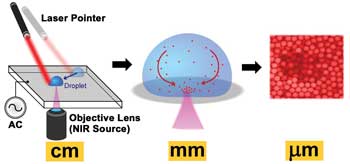Compiled by BioPhotonics staff
A new technology called hybrid optoelectronic manipulation in microfluidics
combines a laser with electric fields and promises a new lab-on-a-chip designed
to manipulate DNA, bacteria and viruses for a variety of fundamental science applications.
Purdue University researchers integrated electric fields and laser
light to manipulate not only large objects like droplets, but also tiny DNA molecules
within those droplets. They said this discovery has enhanced the efficiency of lab-on-a-chip
sensors.

A new technology combines a laser and electric fields to manipulate
fluids and tiny particles such as bacteria, DNA and viruses for a range of potential
applications, including drug manufacturing and food safety. Courtesy of Stuart J.
Williams, University of Louisville.
The technology works by first using a red laser to position a
droplet on a platform created at Purdue. Then, a highly focused infrared laser heats
the droplet, and electric fields cause the heated liquid to circulate in a microfluidic
vortex, used to isolate specific types of particles in the circulating liquid. Particle
concentrations replicate the size, shape and location of the infrared laser pattern.
The process takes less than a second.
The combined technologies are now ready for some applications,
including medical diagnostics and environmental samples, said Stuart J. Williams
of the University of Louisville. “There are two main thrusts in applications,”
he said. “The first is micro- and nanomanufacturing, and the second is lab-on-a-chip
sensors. The latter has demonstrated biologically relevant applications in the past
couple of years, and its expansion in this field is immediate and ongoing.”
Systems that use the hybrid optoelectronic approach can be designed
to precisely manipulate, detect and screen certain types of bacteria, including
particular strains that render heavy metals less toxic. The new method also is a
potential tool for applications including medical diagnostics, crime scene forensics,
pharmaceutical manufacturing, and testing food and water. The scientists also said
it may be used someday as a tool for nanomanufacturing because it shows promise
of suspended colloids.
The findings appeared online May 20 in Lab on a Chip (doi: 10.1039/C1LC20208A).